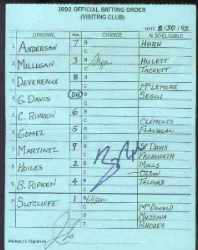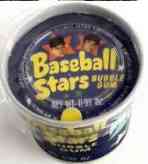Hank Aaron - 2000 Topps LIMITED EDITION 'Reprints' COMPLETE SET
All (23) High-Gloss premium stock Aaron reprints. From each year, 1954 Rookie to 1976 last Topps card. EACH LIMITED to ONLY 4000 !!!
| Grade |
NM/MINT |
| Book Value |
n/a |
| Our Price |
$ 125
Add to cart
|


Below are short bits & pieces on sportscard & baseball trading card collecting.
Please wander around the website for more info, prices, values & images
on vintage baseball, football, basketball, hockey, sport and non-sports cards.
Authentic Major League SIGNED
Game-Used LINEUP Cards (PSA)

These are the official lineup cards SIGNED BY THE MANAGER & given
to the home plate umpire before the game with the team's line-up
& batting order !!! Making them even neater, often managers made
lineup changes on these cards throughout the game.
These official lineup cards were SIGNED BY THE MANAGER and presented
to the home plate umpire before the game. They detailed the team's lineup and
batting order. Managers often made lineup changes on these cards throughout
the game, making them even more unique.
Collectors say "They are official documents of a particular game, so they are
absolutely historically relevant. The manager, he was the general in the war.
Imagine owning Eisenhower's list of who he wanted to go into battle, and then he
signed it !!! Imagine what that would be worth?"
The first dugout lineup cards were seen around 1960. Along with lineup
cards, most ended up in the trash after games, making them quite rare today.
MLB saw the light and started marketing them directly in the 2000's.
Astronomical prices have been paid for cards from special games.
$165,010 for the Red Sox dugout lineup card from Game 4 of the 2004 World Series.
$138,000 in 2007 for 1st ever All-Star Game batting order cards.
$ 40,000 for batting order cards and the pen used to fill them out from
Cal Ripken's 2,130th & 2,131st games.
Click for complete
Major League SIGNED Game-Used LINEUP cards
Note: You may be on that page right now.
|

1970/1972/1973 Topps Candy Lids
Checklist & Values


Topps has tried many crazy products, called "test issues".
Mostly distributed in limited areas, test issues were scarce.
"Candy Lids" were little tubs of candy with player's photos on
bottom of a 1-7/8" lid. 10 cents/tub, 24 tubs/box.
Topps first Candy Lids in 1970 and they are very, very hard to
find. They had small photos of Tom Seaver, Carl Yastrzemski & Frank Howard.


 1970 Topps Candy Lids were called "Baseball Stars Bubble Gum",
had 24 players, the 1973 Topps Candy Lids had 55.
1970 Topps Candy Lids were called "Baseball Stars Bubble Gum",
had 24 players, the 1973 Topps Candy Lids had 55.
Topps planned 1972 Candy Lids but never released it, a few proofs do exist.
 Topps 1973 Pinups & Comics share many of the same photos.
Topps 1973 Pinups & Comics share many of the same photos.
Click for complete
1973 Topps Candy Lids Checklist/Prices
Note: You may be on that page now.
|

1972 Topps AUTOGRAPHED
Baseball Cards Info & Prices
By now you all heard of the rash of counterfeit autographs on the market.
The following autographs all come with auction house LOA's (Letters of Authenticity) from the top
authenticators in the hobby - PSA/DNA or James Spence !!!
Click for complete
1972 Topps Autographed Baseball cards checklist and prices
Note: You may be on that page right now.
|

Baseball card collecting terms (part A)
Airbrushing is the art of touching up a photo prior to the card being printed.
It was generally done to remove imperfections or update or hide a players
jersey/cap logo. Because of advancements in print technology and computers this is
no longer needed.
All-Star card (AS) usually a subset card picturing a player who participated in the
previous seasonís all-star game. Topps created these in their 1958 High Number
issue and has continued the practice fairly regularly to date. Such cards
are usually designated in price guides with the abbreviation of AS.
Assorted A general mix of cards often containing many duplicates.
Auction items are sold to the highest bidder. Auctions used to be live
or thru the mail/phone but today most auctions are online.
Auction Catalog lists the rules and descriptions and often images
of the items in an auction.
Authentication verification that an item (card, autograph) is genuine. Most "game-used"
material inserts have a written declaration of authenticity on the reverse.
Authorized Issue card or memorabilia item that has been properly licensed. If
the item is of a player, his written permission must be given in order for it to be considered authorized.





 These are the official lineup cards SIGNED BY THE MANAGER & given
to the home plate umpire before the game with the team's line-up
& batting order !!! Making them even neater, often managers made
lineup changes on these cards throughout the game.
These official lineup cards were SIGNED BY THE MANAGER and presented
to the home plate umpire before the game. They detailed the team's lineup and
batting order. Managers often made lineup changes on these cards throughout
the game, making them even more unique.
These are the official lineup cards SIGNED BY THE MANAGER & given
to the home plate umpire before the game with the team's line-up
& batting order !!! Making them even neater, often managers made
lineup changes on these cards throughout the game.
These official lineup cards were SIGNED BY THE MANAGER and presented
to the home plate umpire before the game. They detailed the team's lineup and
batting order. Managers often made lineup changes on these cards throughout
the game, making them even more unique.

 Topps has tried many crazy products, called "test issues".
Mostly distributed in limited areas, test issues were scarce.
"Candy Lids" were little tubs of candy with player's photos on
bottom of a 1-7/8" lid. 10 cents/tub, 24 tubs/box.
Topps has tried many crazy products, called "test issues".
Mostly distributed in limited areas, test issues were scarce.
"Candy Lids" were little tubs of candy with player's photos on
bottom of a 1-7/8" lid. 10 cents/tub, 24 tubs/box. 

 1970 Topps Candy Lids were called "Baseball Stars Bubble Gum",
had 24 players, the 1973 Topps Candy Lids had 55.
1970 Topps Candy Lids were called "Baseball Stars Bubble Gum",
had 24 players, the 1973 Topps Candy Lids had 55.  Topps 1973 Pinups & Comics share many of the same photos.
Topps 1973 Pinups & Comics share many of the same photos. 